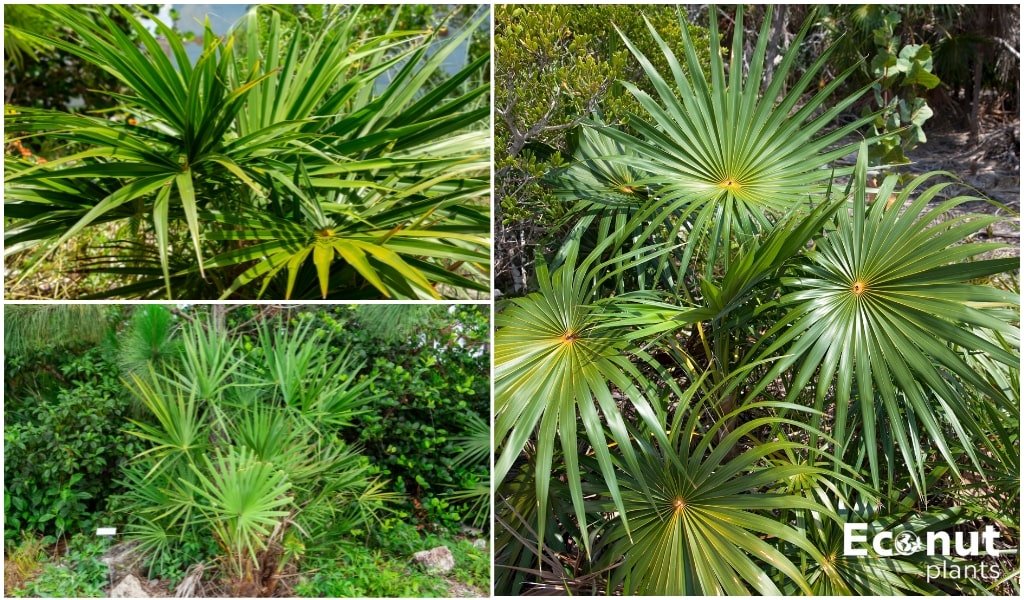Particularly in warm, sunny areas, little palms are a great accent to garden settings. Some little palm cultivars are surprisingly cold-hardy as well, which increases their appeal as versatile plants.
Are you looking for a tiny palm tree for your garden or backyard? Fortunately, there are a wide variety of dwarf palm tree varieties available! We examine the most well-liked tiny palms for your home’s landscaping or garden in this post!
1. Dwarf Palmetto
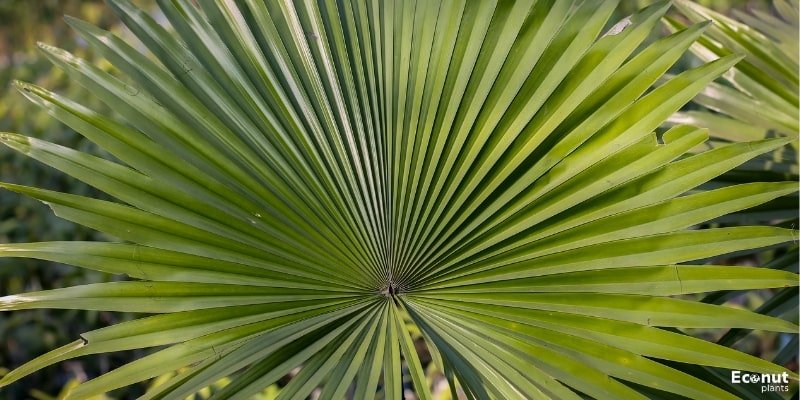
Scientific Name: Sabal minor
Plant Type: Evergreen palm tree or shrub
Plant Size: 5-10 feet tall
Sun Exposure: Full Sun to Partial Shade
It would be difficult for a Floridian to never come across a dwarf palmetto. This little, shrubby tree grows to only 5–10 feet in height. Its leaves originate from a subterranean stock and are usually stemless. Its fan-shaped leaf blades can get up to four feet broad and are longer than the stalks.
As they mature, dwarf palmettos prefer to dwell in a moist, shaded spot with lots of water. Once established, Sabal minor plants may withstand greater drought; however, some browning may occur at the tips of the leaves. All Floridians can appreciate these gorgeous accent plants because they are also hardy in the winter months.
2. Lady Palm
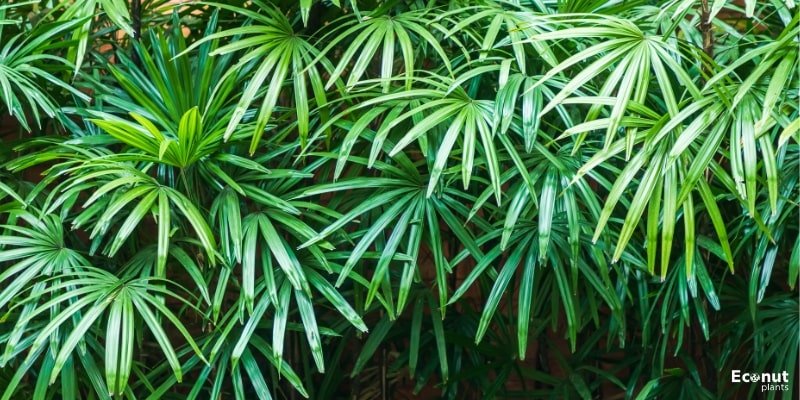
Scientific Name: Rhapis excelsa
Plant Type: Palm
Plant Size: 6–15 ft. tall and wide
Sun Exposure: Full Sun to Partial Shade
Lady palm trees are petite plants that usually grow in dense clusters with thin leaf stalks. Its glossy, brilliant green, fan-shaped fronds have 5-8 segments that resemble lances.
The lady palm can grow happily outdoors, but because it can tolerate low light, it is most often employed as a houseplant. It can endure if its availability to light is restricted for a short while, but it still needs frequent full-sun exposure.
When the earth starts to feel dry, water your springtime lady palm plants. It will grow less than a foot tall per year, even though it can reach up to 15 feet at maturity.
3. Madagascar Palm

Scientific Name: Pachypodium lamerei
Plant Type: Deciduous succulent
Plant Size: Up to 15 feet tall
Sun Exposure: Full Sun
Madagascar palms are deciduous succulents, not palms. They are supported by thorny stems and bluish-green foliage on a broad grey trunk.
The Madagascar palm bears clusters of white, yellow, red, or pink flowers in the spring or summer. These odourless, 4-inch flowers often only open when planted in their natural habitat.
These unusual trees, which resemble palms, require lots of strong sunshine and regular irrigation when the ground is dry. You simply need to irrigate the soil to prevent it from drying up as winter draws near.
4. Yellow Butterfly Palm

Scientific Name: Dypsis lutescens
Plant Type: Perennial
Plant Size: 20–35 ft. tall, 10-20 ft. wide
Sun Exposure: Full Sun
The yellow butterfly palm is a unique, almost threatened palm that resembles bamboo. Like bamboo leaves, they have smooth, golden-hued trunks with broad, slender fronds.
In many tropical places, yellow butterfly palms are employed as privacy barriers. Although they grow slowly too moderately, planting them in the spring promotes optimal growth.
Although they will thrive in full sun, they prefer filtered sunshine. Rich, slightly acidic soil that drains well is ideal for yellow butterfly palms; the soil should also be evenly hydrated.
5. Sago Palm

Scientific Name: Cycas revoluta
Plant Type: Cycad
Plant Size: 3-10 feet tall and wide
Sun Exposure: Full Sun to Partial Shade
The Sago palm isn’t a true palm tree, just like the Madagascar palm. It belongs to the family Cycads, is usually slow-growing, and bears neither fruit nor flowers.
Measuring barely 3 to 10 feet in height, they resemble a large palm-like bush perched atop a short trunk with no outgrowth. It can take up to 50 years to reach its maximum height of 10 feet; after several years, it frequently stops around 2-3 feet.
Be cautious while selecting a location for your sago palm in your yard because all of its parts, including its nuts and seeds, are harmful to both people and pets.
6. Parlor Palm

Scientific Name: Chamaedorea elegans
Plant Type: Palm
Plant Size: 6-16 feet tall
Sun Exposure: Bright, indirect light
The low light requirements of parlour palms make them extremely attractive indoor palm trees. In striking clumps, they have deep green leaves. Most have several stalks, giving them the appearance of tropical plants; however, some have just one.
Sand, loamy, or clay soils are all suitable for the growth of these low-maintenance palms; saline soil is not recommended. Although they prefer medium levels of moisture, they would choose extreme dryness over excessive wetness.
7. Jelly Palm
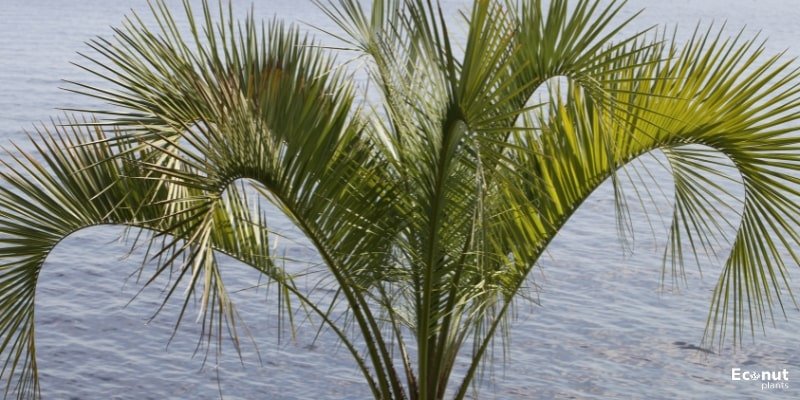
Scientific Name: Butia capitata
Plant Type: Palm
Plant Size: 12 to 15 feet tall
Sun Exposure: Full Sun
The tiny palm trees known as jelly palms, or pindo palms, have bluish-grey fronds. The length of its leaf stalks can reach four feet, and their edges taper.
In the autumn or winter, this palm bears vivid orange-yellow fruits. Its fruit has a tangy and sweet flavour and is edible. Though you can use it for jams or jellies, many Pindo palm owners will eat it straight off the tree.
The jelly palm is tolerant of most soil types as long as it drains properly, and it may grow in both full and partial shade. Plant jelly palms at least 10 feet away from any paved surfaces, as dropping fruit can be untidy.
8. Florida Thatch Palm
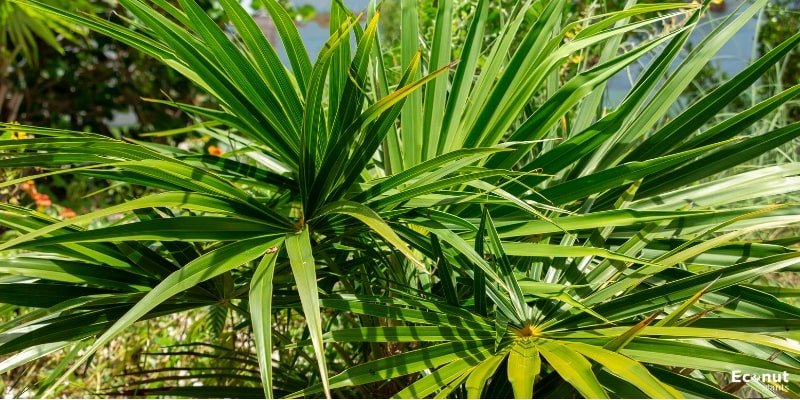
Scientific Name: Thrinax radiata
Plant Type: Palm
Plant Size: 15 to 20 feet tall
Sun Exposure: Full Sun
The Florida thatch palm is a small, slow-growing palm that typically only grows half a foot a year. Its usual growth is 15 to 20 feet tall, yet it can grow as high as 30 feet.
This endemic to Florida features dark green, fan-shaped leaves that can grow up to three feet long on a slender, grey stem. Springtime brings white blossoms and green fruit that turn white when it ripens.
Florida thatch palms can withstand dryness and salinity, but they need a lot of humidity. It grows well on well-drained, sandy soil that is consistently moist. During the growing season, give this palm a high-quality palm fertilizer twice a year to maintain its health.
9. Dwarf Sugar Palm

Scientific Name: Arenga engleri
Plant Type: Palm
Plant Size: up to 10 feet tall
Sun Exposure: Full Sun
The slow-growing dwarf sugar palm, often called the Formosa palm, reaches a maximum height of 10 feet but typically stops at 8 feet. In their hardiness zones, these palms can withstand cold temperatures, which make them appropriate for northern regions.
Its trunks are smooth and thin, with rings of rich green foliage. Growing up to 8 feet tall and spreading 16 feet in total, its yellowish-green leaves have a wide spread. Evocative and fragrant blossoms precede the inedible fruits of the dwarf sugar palm.
The moist soil and consistent fertilization are ideal for dwarf sugar palm growth. It doesn’t like the earth to get dry and needs an abundance of water. This resistant palm may withstand brief excursions up to 25 degrees Fahrenheit once it is established.
10. Christmas Palm
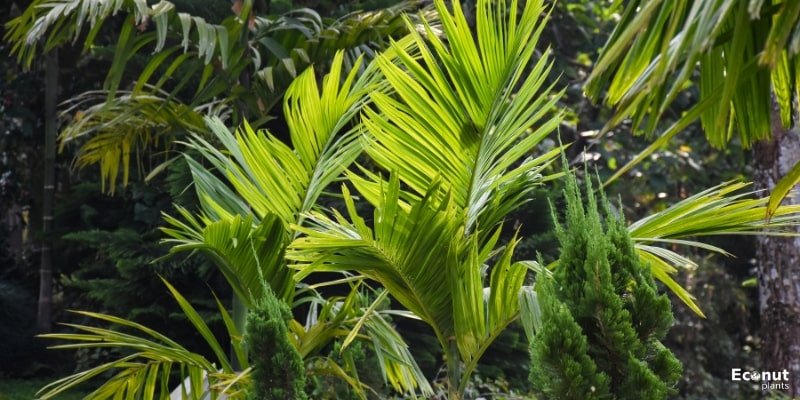
Scientific Name: Adonidia merrillii
Plant Type: Palm
Plant Size: Up to 25 feet
Sun Exposure: Full sun but can tolerate partial shade
The Christmas palm, commonly called the Manila palm, gets its popular name from the bunches of eye-catching red berries it bears in the autumn and winter.
Compared to other palms on our list, Christmas palms can grow up to 25 feet tall and 8 feet wide. Because grouping causes the Christmas palm’s trunk to develop in a soft curve, many gardeners will plant their trees in groups of two or four.
Christmas palms prefer full sun, though they can grow in moderate shade. There will be less need for pruning because these self-cleaning palms will naturally shed their old leaves. They are particularly vulnerable to deadly yellowing, which resembles a primitive virus, even though they require little care.
11. Buccaneer
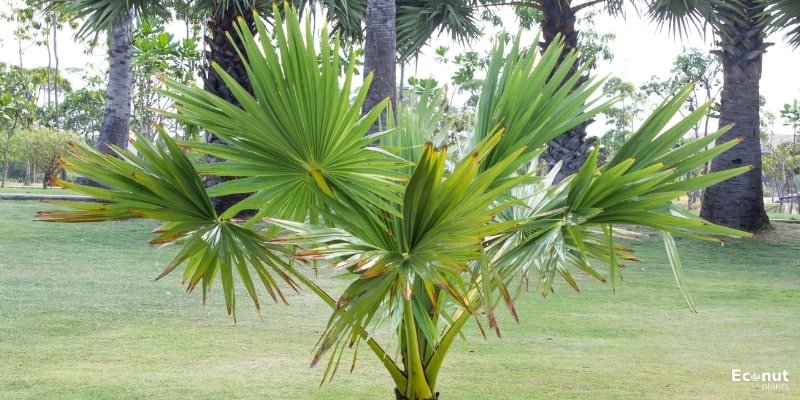
Scientific Name: Pseudophoenix sargentii
Plant Type: Palm
Plant Size: 10-15 ft tall and wide
Sun Exposure: Full Sun
The smooth grey stem of buccaneer palms lacks a crown shaft, and their feathery, deep green leaves can reach a maximum length of 15 feet.
In the summer, they bear small yellow blooms that become red when they ripen, and then they bear green fruits. Although these little fruits are inedible, they give your garden’s palms more personality.
Buccaneers favour alkaline, well-drained soil. Use a continuous-release palm fertilizer a few times a year during the growing season for optimal results.
12. Bottle Palm

Scientific Name: Hyophorbe lagenicaulis
Plant Type: Palm
Plant Size: 10 feet tall
Sun Exposure: Full Sun
The Mascarene Islands are home to the bottle palm, which is regarded as severely endangered. Its common name comes from its unusual trunk, which resembles a bottle. The trunk of the bottle palm is rounded while the tree is younger, but it grows longer as it gets older.
These unusual palm trees are barely ten feet tall, yet their fronds can get up to twelve feet broad and two feet long in the leaflets.
Bottle palms require frost protection. When the weather gets cold, knot the tree’s fronds up gently and cover or blanket it. A bottle palm requires minimal maintenance as long as it is planted in well-drained soil, receives plenty of sunlight, and has reasonable moisture levels.
13. Arikury Palm

Scientific Name: Syagrus schizophylla
Plant Type: Palm
Plant Size: 6-13 feet tall
Sun Exposure: Full Sun to Partial Shade
The arikury palm, commonly referred to as the parrot palm or parrot beak palm, is an ideal inclusion for a petite tropical garden. Even though the parrot palm and the queen palm are related, the parrot palm is a unique tree that stands out due to its huge 6-foot fronds and shorter, narrow stem.
Since their fronds grow erect, these tiny palms are rather compact and usually only take up a few feet of space in your yard. Furthermore, Arikury palms can withstand temperatures as low as 28 degrees Fahrenheit for brief periods, though they usually like it much warmer!
This unusual palm tree doesn’t need much upkeep and grows slowly. Most of the time, you won’t need to worry about pruning spent fronds. Arikury palms dislike damp soil, but they do require a lot of water—at least twice a week during dry spells.
14. Cat Palm

Scientific Name: Chamaedorea cataractarum
Plant Type: Palm
Plant Size: up to 6 feet tall
Sun Exposure: Full Sun
The bushy leaves of the Areca palm are similar to those of the cat palm, also known as the cataract palm or cascade palm. The cat palm has vivid green stems, whereas the areca palm has yellow ones. They usually don’t get much higher than six feet or eight feet across.
When displayed in a residence during the Victorian era, cat palms were considered a symbol of high social rank. Many owners would gladly show off their trees through the windows so that people could see that they were wealthy.
Err on the side of excess food rather than insufficient, as they enjoy eating plant-based foods. You should avoid allowing the soil to get too dry and instead keep it damp to maintain the health of your cat palm.
15. European Fan Palm

Scientific Name: Chamaerops humilis
Plant Type: Palm
Plant Size: 6-15 feet tall and 6-20 feet wide
Sun Exposure: Full Sun to Partial Shade
The European fan palm, also known as the Mediterranean dwarf palm, is a cold-hardy palm that can withstand brief dips below 10 degrees Fahrenheit. Certain European fan palms mature into trees with a single trunk or into shrubs with several trunks.
It has silvery or bluish-green fronds that extend out into small leaflets. In the spring, the European fan palm bears clusters of vivid yellow blooms, which are followed by tiny fruits.
Although they prefer full light, these slowly growing plants may survive in some shade. It may become lanky if it doesn’t receive four hours or more of direct sunlight on most days. It needs well-watered soil before it can take root, but as it gets older, it can withstand some drought.
16. Pygmy Date Palm

Scientific Name: Phoenix roebelenii
Plant Type: Palm
Plant Size: Up to 22 feet tall
Sun Exposure: Full Sun
The pygmy date palm has dark green fronds that form a crown and a grey trunk with a purple tint. Its common name comes from the little yellowish flowers it produces in the spring, which are followed by sweet, edible fruits that resemble dates.
This little to medium-sized plant grows about 3–4 inches in height per year, making it a very sluggish grower. Although they can withstand temperatures as low as 26 degrees Fahrenheit for brief periods, pygmy date palms are found in tropical and subtropical regions.
Established pygmy date palms have considerable resistance to drought, can withstand most types of soil, and are resistant to pests. Furthermore, it won’t require a lot of pruning to have a sturdy structure.
17. Saw Palmetto
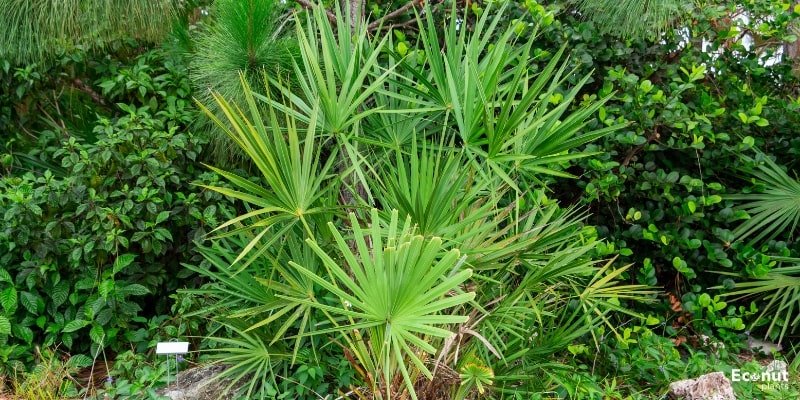
Scientific Name: Serenoa repens
Plant Type: Shrubby palm tree
Plant Size: Up to 10 feet tall
Sun Exposure: Full Sun
Saw palmettos are among the most widespread palm trees in the United States and can be found naturally in many southern states. They can grow in a variety of environments, such as marshy wetlands and coastal dunes. It can yield little blackberries and grow tall, pointed leaves.
Some people use saw palmetto because of its possible health advantages for several ailments, including diseases related to male and female reproduction.
One of the easiest plants to maintain is saw palmetto because it can grow in a variety of climates. Give it lots of water when there’s a drought.
18. Windmill Palm

Scientific Name: Trachycarpus fortunei
Plant Type: Hardy evergreen
Sun Exposure: Full Sun to partial shade
Plant Size: 10 – 20 ft.
The dwarf palm tree, known as the windmill palm, grows slowly and usually reaches a height of 10 to 20 feet (3 to 6 meters). The windmill palm is topped with a crown of massive, fan-shaped leaves that can reach a diameter of up to three feet (1 meter). It bears clusters of tiny yellow blooms in the spring.
Although it can withstand full sun, the windmill palm grows best in partial to full shade. Though it can withstand a variety of soil types, including sandy, loamy, and clay soils, as long as they are not very alkaline or saline, it loves fertile, well-draining soil.
The windmill palm is suited for areas with cooler climates since it can withstand minimum temperatures as low as 10 to 15°F (-12 to -9°C).
19. Spindle Palm

Scientific Name: Trachycarpus fortunei
Plant Type: Evergreen palm
Sun Exposure: Full sun but can tolerate light shade
Plant Size: 10 – 20 ft.
The spindle palm is a little palm tree that grows to a height of roughly 3–6 meters (10–20 feet). The spindle palm can withstand some mild shade but prefers full sun. It prefers soil that is fertilized and well-drained.
The optimal temperature range is between 15 and 29°C (60 and 85°F). In tropical gardens or coastal landscaping projects, it is frequently used as a focal point.
Though they are very widespread as interior plants, palms are most commonly employed outdoors. Additionally, if you are in a temperate zone, spindle palms grow well in pots.
20. Coontie Palm

Scientific Name: Zamia floridana
Plant Type: Shrub
Sun Exposure: Full sun to partial shade
Plant Size: 3 ft. (1 m)
Native to Florida, the Coontie palm tree grows slowly. It is distinguished by its glossy, fern-like, light green leaves. It is actually a woody cycad rather than a true palm. Up to three feet (1 meter) can be reached by the palm. The palm yields brilliant orange seeds in reddish-brown cones that can be used for multiplication, but neither flowers nor fruits.
Full sun is preferable to partial shade for the coontie palm. It is advised to cultivate palms between 75 and 90°F (25 and 32°C), even if they can withstand lower temperatures. It favours soil with good drainage.
21. Golden Cane Palm

Scientific Name: Dypsis lutescens
Plant Type: Perennial
Sun Exposure: Full sun to partial shade
Plant Size: 20 to 35 ft.
Compact gardens can benefit from the bushy growth of the golden cane palm, which grows quite slowly. With lance-shaped leaflets, a multi-stemmed trunk, compact egg-shaped fruits, and dark green V-shaped fronds that are 6 to 8 feet (1.8 to 2.4 meters) tall, this elegant shrub-like palm is easily recognizable.
Alternatively known as the yellow bamboo palm or areca palm, this bushy palm reaches heights of 20 to 35 feet (6 to 10 meters) and a width of 10 to 20 feet (3 to 6 meters) at the base of its crown. The golden cane palm can be found in landscapes that have well-drained soil, full sun to moderate shade, and an abundance of water.
The golden cane palm is another well-liked indoor container plant, much like the lady palm.
Conclusion
The palms on this list can make a great impact despite their diminutive size. Adding palms to your yard will give it a unique and appealing appearance.
With frequent pruning, several of these palms can be intentionally kept short, and all are ideal for compact garden spaces. You can achieve the desired tropical vibe in your yard with a dwarf palm on our list with a little care!

